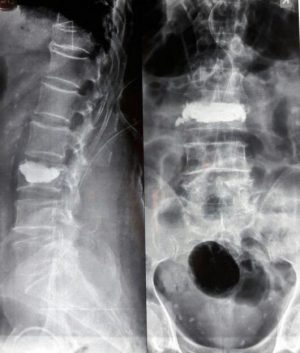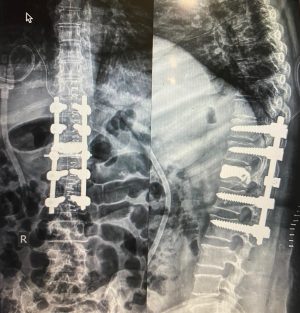Kyphoplasty/ Vertebroplasty
Kyphoplasty vs Vertebroplasty
Bone cement injection in a fractured vertebra can provide pain relief. Vertebroplasty is cementing fractured vertebral body with bone cement using needles. Kyphoplasty involves first inserting an inflatable balloon in the vertebral body to create space and then injecting bone cement in this space created (Balloon Kyphoplasty). Kyphoplasty restores collapsed vertebral height and can create space in severely collapsed vertebrae where vertebroplasty was not possible.
Indications of Vertebroplasty/ Kyphoplasty:
- Osteoporotic Vertebral Body Fracture: Cementing provides internal support to collapsed vertebral body. This causes immediate reduction in pain of vertebral fracture. Also, it reduces further chances of vertebral collapse, which carries the risk of 1) increased pain, 2) kyphotic posture, and 3) chance of spinal cord compression by displaced vertebral body fragments. Vertebroplasty/ kyphoplasty is mostly done as stand-alone procedure. However, it can be combined with spine instrumentation surgery for unstable fractures and in severe vertebral collapse. A severely collapsed vertebra will not have enough space for sufficient cement filling.
- Spinal Tumors: Vertebroplasty/ kyphoplasty can be done as a palliative procedure in vertebral body collapse secondary to spinal tumors. This is primarily done for pain relief. Spine instrumentation is usually also done to provide support to vertebral column.
- Osteoporotic Spine Instrumentation: Spinal implants have poor hold in severely osteoporotic bones. Vertebroplasty immediately before placing pedicle screws will increase screw hold in these weak bones and reduce chances of implant loosening.
Complications and Side Effects of Vertebroplasty/ Kyphoplasty:
- Cement Leak: A cement leak in the spinal canal can cause pressure on spinal cord. Cement leak usually happens when vertebroplasty is done in acute fractures and when vertebral body is fractured severely. It is recommended to wait 2-3 weeks for vertebroplasty after fracture develops. This will seal-off fracture crevices and will reduce the chances of cement leak. Kyphoplasty has less chances of cement leak as it will create space within vertebral body to accommodate cement. Kyphoplasty also create a shell of bone around inflated balloon, which will also prevent cement leak.
- Progressive Vertebral Collapse: Cement usually occupies current fracture void in the vertebral body. Remaining part of vertebral body might occasionally collapse later on in severely osteoporotic bone. Instrumentation surgery along with vertebroplasty prevents this complication.
- Fracture of adjacent vertebrae: As osteoporosis is a systemic disease. It’s not only the fractured vertebra which is affected by osteoporosis. Other bones of the body and vertebrae are also affected by osteoporosis. It is not uncommon for other vertebrae to collapse in future due to osteoporosis. This require treatment on individual basis. This is more common in patients who do not receive medical treatment for osteoporosis after treating previous vertebral collapse. These patients are also prone to develop hip and wrist fractures due to osteoporosis affecting these bones.
Advantages of Kyphoplasty vs Vertebroplasty:
- Kyphoplasty reduces chances of cement leakage,
- More cement can be injected in the created spaces to provide better support to vertebral body,
- Kyphoplasty can restore vertebral body height, thus correcting kyphosis.
However, kyphoplasty is costlier than vertebroplasty as it requires additional specialized instruments. It is not necessary to use kyphoplasty over vertebroplasty in every vertebral fracture.


